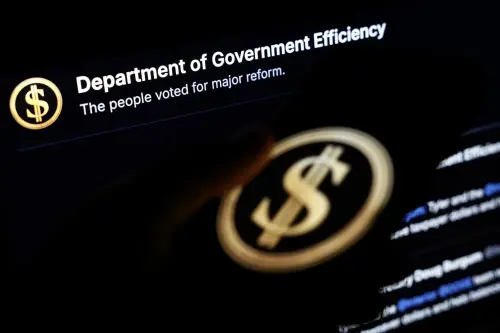When it comes to voting, Democrats and Republicans cultivate their own myths. Democrats are sure that there are millions of voters out there who, if it were easy to vote, would vote for them. Republicans are equally sure that if voting is too easy it would lead to a large turnout of people who don’t vote as often and they would never win. Now that the coronavirus has states and citizens looking for safer ways to vote, many states are moving toward mail-in ballots of one form or another. Predictably, the arguments that have emerged about mail ballots have little to do with their utility in a pandemic—obviously, voting by mail is safer than going to a crowded polling place.
Mail-in ballots, in the age of COVID-19, have turned into a partisan brawl which, to no one’s surprise, President Trump started. “Republicans should fight very hard when it comes to statewide mail-in voting. Democrats are clamoring for it,” Trump wrote on Twitter recently. “Tremendous potential for voter fraud, and for whatever reason, doesn’t work out well for Republicans.” So far there are legal battles in Arizona, California, Florida, Nevada, North Carolina, Oklahoma, Pennsylvania, Texas, Virginia and Wisconsin. Partisan groups are battling over everything from whether absentee ballots should be witnessed to whether making voters pay for postage is a poll tax.
Ironically, for all the hollering, there is little evidence that mail-in voting systems favor one political party or the other. The first state to adopt a universal mail-in ballot program was Oregon in 2000. Shortly after it was enacted, Adam J. Berinsky, Nancy Burns, and Michael W. Traugott sought to explore the impact of the new law. They found that voting by mail did not bring substantial numbers of new voters into electorate, nor did it have any effect on whether the electorate was more Democratic or more Republican. The only effect they found was that it helped keep regular voters in the electorate.
Since then there have been many studies seeking to understand whether or not there is a partisan bias to election reforms designed to make it easier to vote, of which vote-by-mail is one. A study published in 2005 by Adam Berinsky came to a surprising and counter-intuitive conclusion about electoral reforms designed to increase turnout among less-privileged voters. He writes, “I review evidence from numerous studies of electoral reform to demonstrate that reforms designed to make it easier for registered voters to cast their ballots actually increase, rather than reduce, socioeconomic biases in the composition of the voting public.”[1] So much for the Democratic myth.
Michael Alvarez, Ines Levin and J. Andrew Sinclair looked at a large sample of voters from the 2008 presidential election and found “little support for the hypothesis that convenience voting methods have partisan implications, despite the differences among mail, early, and Election Day voters.”[2]
A study published in 2017 by Barry C. Burden, David T. Canon, Kenneth R. Mayer and Donald P. Moynihan looked at reforms making it easier to register to vote. They found that “Unlike Election Day registration, and contrary to conventional wisdom, the results show that early voting generally helps Republicans. We conclude with implications for partisan manipulation of election laws.” So much for the Republican myth.
But a study by Ethan Kaplan and Haishan Yuan published in 2020 concludes, “We find substantial positive impacts of early voting on turnout equal to 0.22 percentage points of additional turnout per additional early voting day. We also find greater impacts on women, Democrats, independents, and those of child-bearing and working age.”
One of the most widely cited studies on this issue was done by Andrew Hall, Daniel Thompson and Jesse Yoder at Stanford University. There are three states, California, Utah and Washington, that implemented their vote-by-mail systems county by county instead of statewide. Because they rolled out vote-by-mail in a staggered fashion, the researchers could compare turnout and the partisan vote in the same elections with counties that did and did not use vote-by-mail. They compared these counties over a series of elections from 1998 to the 2018 midterms. The study has the advantage of being what social scientists call “a natural experiment,” meaning that voters in the same election could be compared by how they voted—by mail or in person. It is also the largest study ever done on this topic. They find that, “The expansion of vote-by-mail does not appear to tilt turnout towards the Democratic party, nor does it appear to affect election outcomes meaningfully.”
It is a shame that this issue should have fallen prey to the intense polarization of our times. Mail-in balloting does not give one party or the other a substantial advantage. Utah, for instance, was a solidly Republican state before and after mail-in voting and California is likely to remain a solidly Democratic state whether it votes by mail or not. In the era of COVID-19, the decision to move to mail-in ballots should be a public health issue, not a partisan issue.
But when even wearing a face mask becomes a partisan issue, should we really be surprised?
[1] Berinsky, Adam J. “The Perverse Consequences of Electoral Reform in the United States.” American Politics Research, vol. 33, no. 4, July 2005, pp. 471–491, doi:10.1177/1532673X04269419.
[2] Alvarez, R. Michael, et al. “Making Voting Easier: Convenience Voting in the 2008 Presidential Election.” Political Research Quarterly, vol. 65, no. 2, 2012, pp. 248–262. JSTOR, www.jstor.org/stable/41635231.
The Brookings Institution is committed to quality, independence, and impact.
We are supported by a diverse array of funders. In line with our values and policies, each Brookings publication represents the sole views of its author(s).







Commentary
Mail-in ballots, the coronavirus, and a partisan brawl
May 29, 2020